人教版(2019)选择性必修第一册Unit 4 Body Language Writing 常见的动作细节描写课件(23张ppt)
文档属性
| 名称 | 人教版(2019)选择性必修第一册Unit 4 Body Language Writing 常见的动作细节描写课件(23张ppt) | 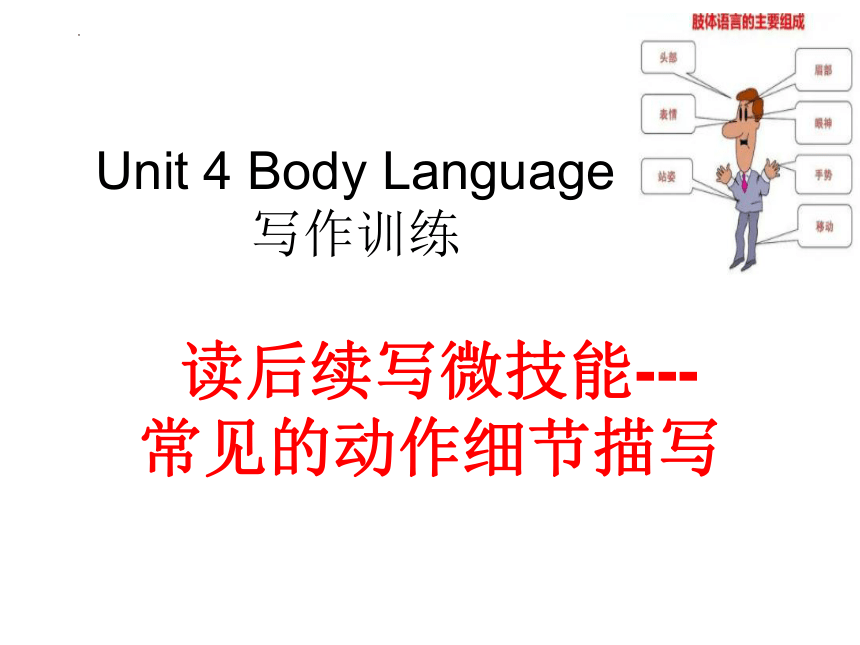 | |
| 格式 | pptx | ||
| 文件大小 | 1.4MB | ||
| 资源类型 | 教案 | ||
| 版本资源 | 人教版(2019) | ||
| 科目 | 英语 | ||
| 更新时间 | 2022-10-25 10:53:02 | ||
图片预览

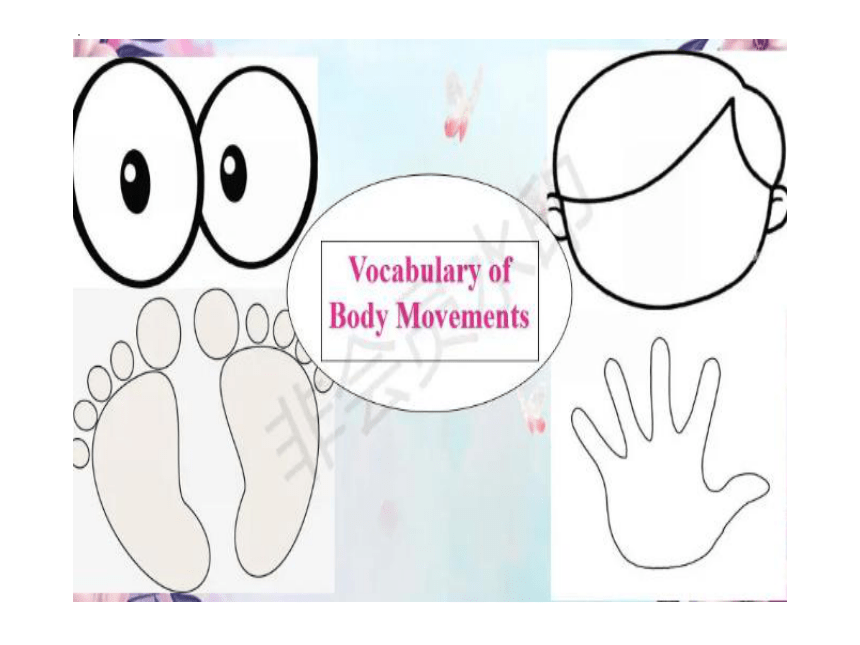
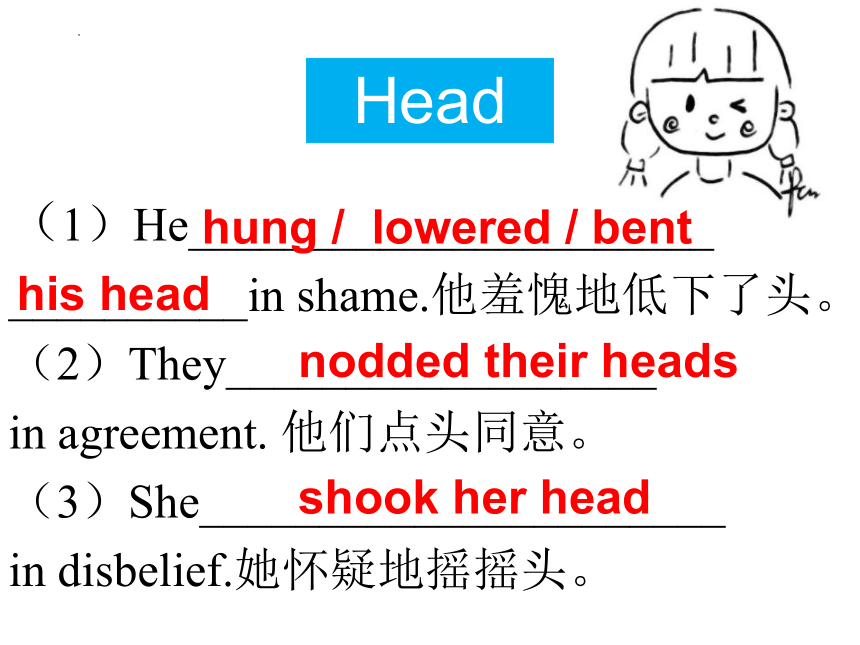
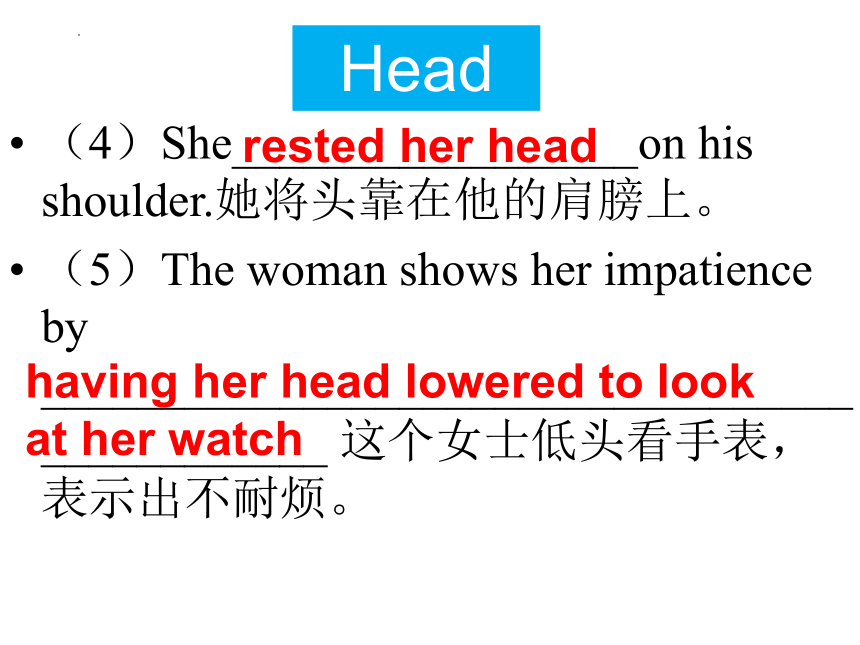
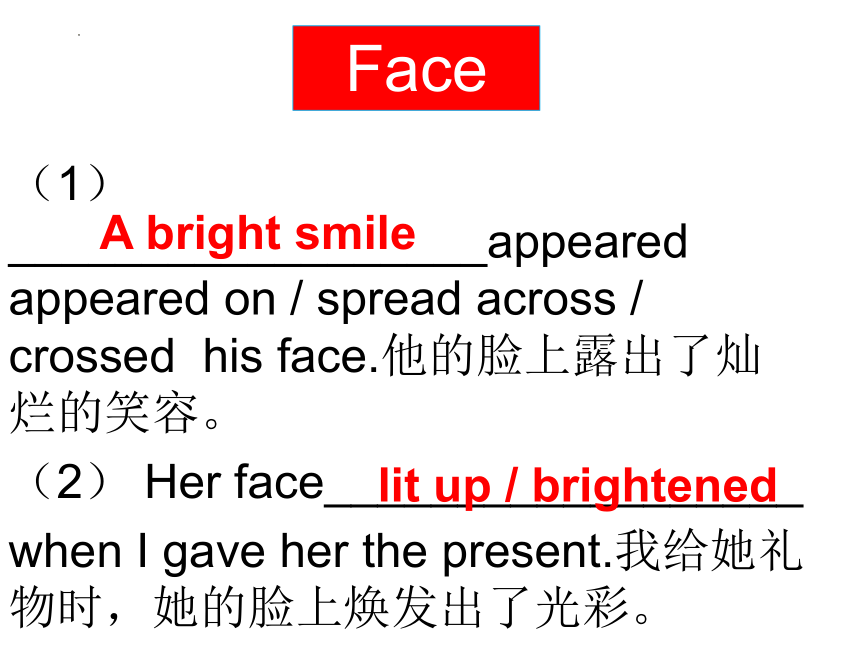
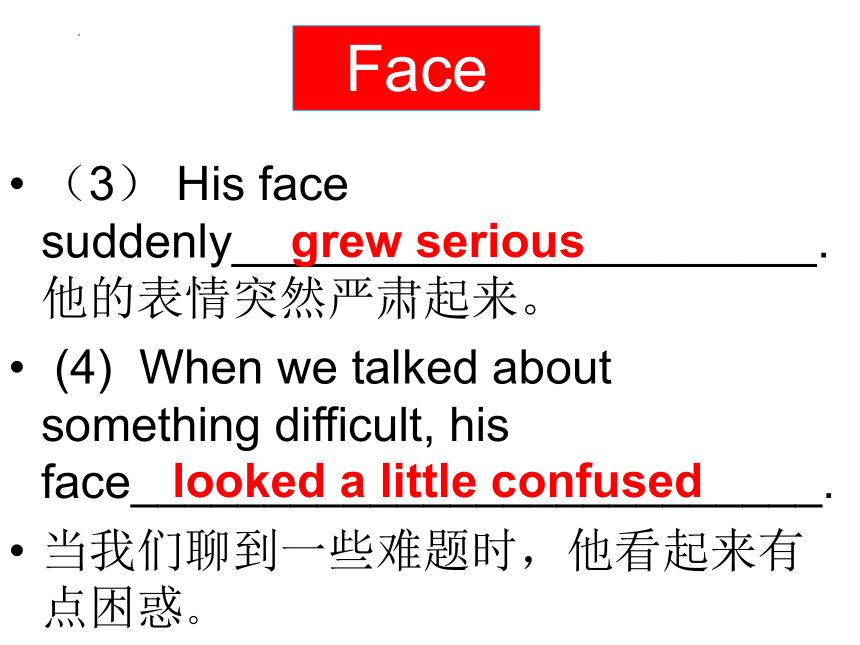
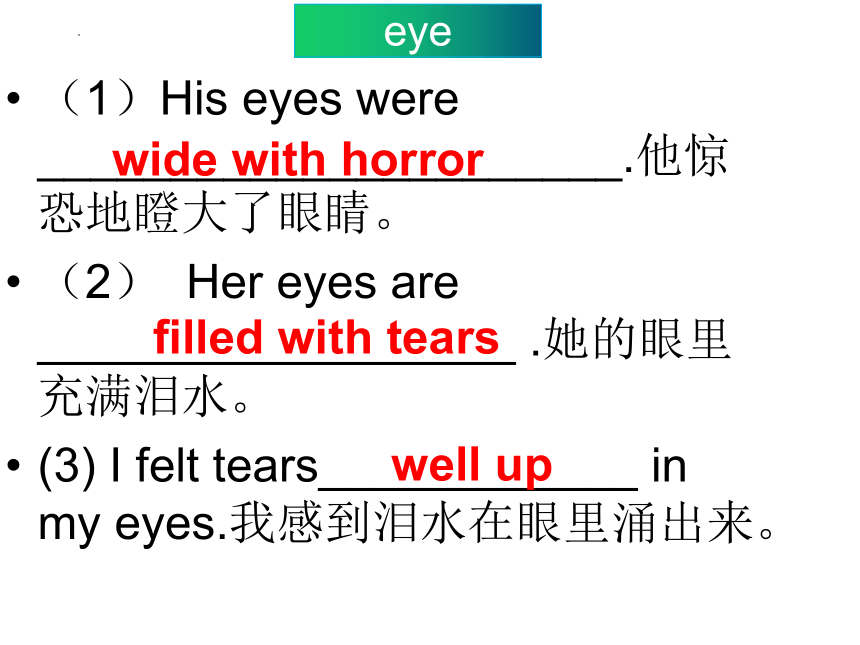
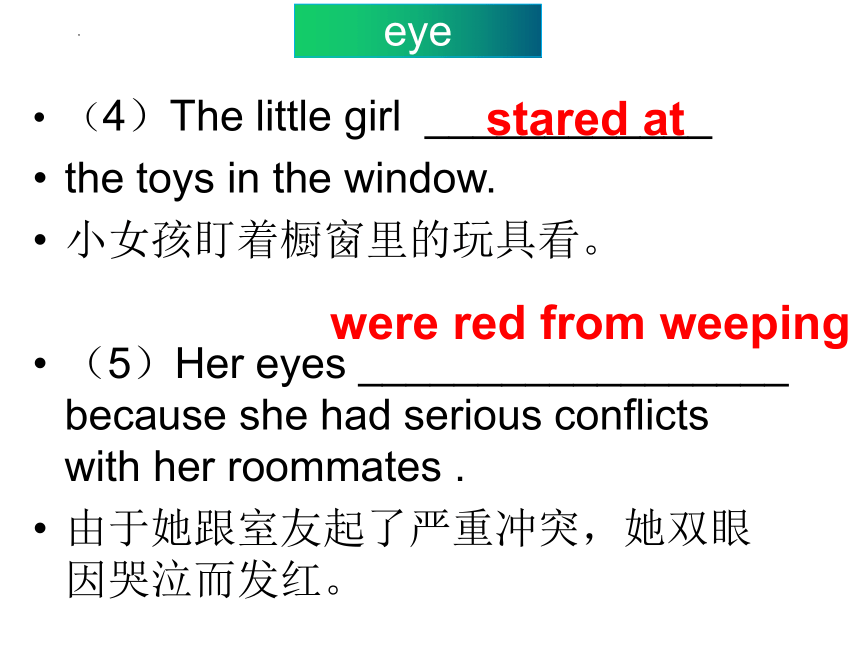
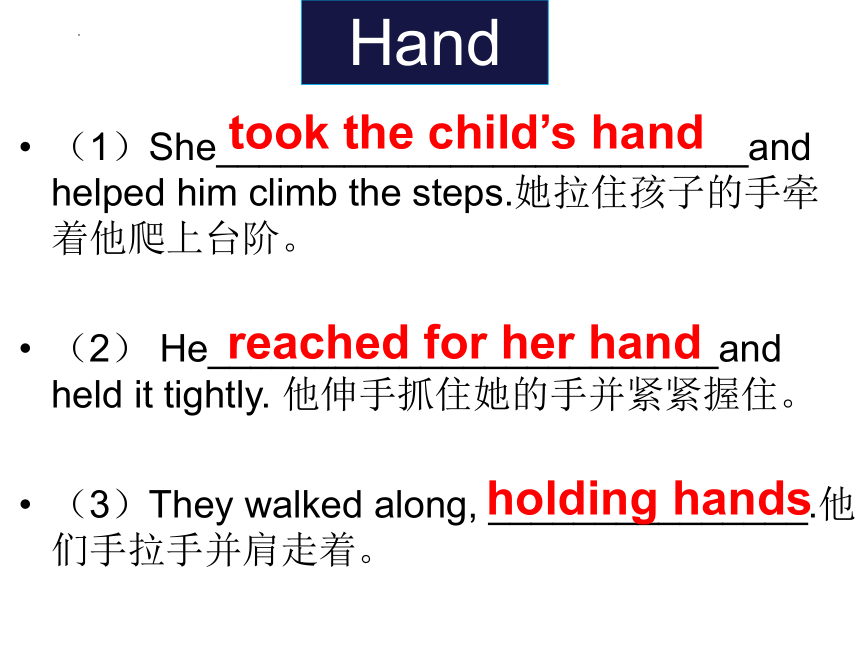
文档简介
(共23张PPT)
Unit 4 Body Language
写作训练
读后续写微技能---常见的动作细节描写
Head
(1)He______________________
__________in shame.他羞愧地低下了头。
(2)They__________________
in agreement. 他们点头同意。
(3)She______________________
in disbelief.她怀疑地摇摇头。
hung / lowered / bent
his head
nodded their heads
shook her head
(4)She_________________on his shoulder.她将头靠在他的肩膀上。
(5)The woman shows her impatience by ______________________________________________ 这个女士低头看手表,表示出不耐烦。
Head
rested her head
having her head lowered to look at her watch
(1)__________________appeared appeared on / spread across / crossed his face.他的脸上露出了灿烂的笑容。
(2) Her face__________________
when I gave her the present.我给她礼物时,她的脸上焕发出了光彩。
Face
A bright smile
lit up / brightened
(3) His face suddenly______________________.他的表情突然严肃起来。
(4) When we talked about something difficult, his face__________________________.
当我们聊到一些难题时,他看起来有点困惑。
Face
grew serious
looked a little confused
(1)His eyes were ______________________.他惊恐地瞪大了眼睛。
(2) Her eyes are __________________ .她的眼里充满泪水。
(3) I felt tears____________ in my eyes.我感到泪水在眼里涌出来。
eye
wide with horror
filled with tears
well up
(4)The little girl ____________
the toys in the window.
小女孩盯着橱窗里的玩具看。
(5)Her eyes __________________ because she had serious conflicts with her roommates .
由于她跟室友起了严重冲突,她双眼因哭泣而发红。
eye
stared at
were red from weeping
(1)She_________________________and helped him climb the steps.她拉住孩子的手牵着他爬上台阶。
(2) He________________________and held it tightly. 他伸手抓住她的手并紧紧握住。
(3)They walked along, _______________.他们手拉手并肩走着。
Hand
took the child’s hand
reached for her hand
holding hands
(4)He______________________as if we were long lost friends.他握住我的手好像我们是失散多年的朋友。
(5)The boy fell asleep ____________________________in class. 那个男孩上课睡着了,手托着下巴。
Hand
shook my hands
with his chins on his hands
(1)She crossed the finish line______________________.她用她那疲惫的双腿穿过了终点线。
(2)He______________________on shaky legs.他双腿颤抖地站了起来。
(3)His legs were so weak that he could hardly _______.他腿软的几乎站不住了。
(4) She______________________when she heard the news.当她听到这个消息时,她跳了起来。
Leg / Foot
on tired legs
rose to his feet
stand
jumped to her feet
动作描写——构造动作链
He stopped it (the taxi), jumped in with the suitcase and told the driver,
“Go to the police station, please.”
——2016年浙江考试说明样题范文
上车 = 拦车+跳上车+告诉目的地
动作链
She would get off the car excitedly, laughing and dancing around.
——2017年10月浙江卷优秀范文
下车 = 下车+笑+跳
(1)
The boys___________excitedly to the lake,___________their clothes and___________intothe water.
A, B and C结构
跳入湖里嬉戏 = 冲向湖边 + 脱掉衣服 + 跳入水中
rushed
took off
jumped
(2)
She dashed forward, knelt down
and ___________her son into her arms.
A, B and C结构
抱住儿子 = 冲向前 + 蹲下 + 一把抱住
gathered
(3)
The singer _________ the audience,______a deep breath and began to _____.
A, B and C结构
歌手唱歌 = 扫视观众 + 深吸一口气 + 开始演唱
took
sing
glanced at
(1)原句:My mom handed five dollars to the poor man.
My mom opened the purse, took out five dollars, and handed it to the poor man.
给钱 = 打开钱包 + 取出五美元 + 递给那个可怜的人
(2)原句:I put the envelop into his mailbox quietly.
I walked straight to his mailbox, put the envelope into it, and then left the house quietly.
把信封放进邮箱 = 走向邮箱 + 把信封放进去 + 悄悄离开他家
(1)-ing现在分词,凸显同一逻辑主语、主动、同时
The old man sat under the sunset, ___________the newspaper and___________the radio.
使用非谓语
老人静坐=坐在夕阳下 + 看报纸 + 听广播
reading
listening to
(2)having done 表现动作先后关系
____________for 3 hours, he was told that the ticket had been sold out.
使用非谓语
没有买到票= 排了很久队 + 被告知票卖完了
Having queued
(3)-ed过去分词凸显被动
___________ by the story, the children began to cry.
使用非谓语
感动哭了= 被感动 + 哭了
Moved
Ex:
1. 他静静地站在原地,一句话也没有说。
(1). He stood there quietly, not saying any word
(2). Standing there quietly, he didn’t say any word.
2. 思考了一整晚之后,他下定决心把真相告诉老师。
Having thought for a whole night,
he made up his mind to tell his
teacher the truth.
Unit 4 Body Language
写作训练
读后续写微技能---常见的动作细节描写
Head
(1)He______________________
__________in shame.他羞愧地低下了头。
(2)They__________________
in agreement. 他们点头同意。
(3)She______________________
in disbelief.她怀疑地摇摇头。
hung / lowered / bent
his head
nodded their heads
shook her head
(4)She_________________on his shoulder.她将头靠在他的肩膀上。
(5)The woman shows her impatience by ______________________________________________ 这个女士低头看手表,表示出不耐烦。
Head
rested her head
having her head lowered to look at her watch
(1)__________________appeared appeared on / spread across / crossed his face.他的脸上露出了灿烂的笑容。
(2) Her face__________________
when I gave her the present.我给她礼物时,她的脸上焕发出了光彩。
Face
A bright smile
lit up / brightened
(3) His face suddenly______________________.他的表情突然严肃起来。
(4) When we talked about something difficult, his face__________________________.
当我们聊到一些难题时,他看起来有点困惑。
Face
grew serious
looked a little confused
(1)His eyes were ______________________.他惊恐地瞪大了眼睛。
(2) Her eyes are __________________ .她的眼里充满泪水。
(3) I felt tears____________ in my eyes.我感到泪水在眼里涌出来。
eye
wide with horror
filled with tears
well up
(4)The little girl ____________
the toys in the window.
小女孩盯着橱窗里的玩具看。
(5)Her eyes __________________ because she had serious conflicts with her roommates .
由于她跟室友起了严重冲突,她双眼因哭泣而发红。
eye
stared at
were red from weeping
(1)She_________________________and helped him climb the steps.她拉住孩子的手牵着他爬上台阶。
(2) He________________________and held it tightly. 他伸手抓住她的手并紧紧握住。
(3)They walked along, _______________.他们手拉手并肩走着。
Hand
took the child’s hand
reached for her hand
holding hands
(4)He______________________as if we were long lost friends.他握住我的手好像我们是失散多年的朋友。
(5)The boy fell asleep ____________________________in class. 那个男孩上课睡着了,手托着下巴。
Hand
shook my hands
with his chins on his hands
(1)She crossed the finish line______________________.她用她那疲惫的双腿穿过了终点线。
(2)He______________________on shaky legs.他双腿颤抖地站了起来。
(3)His legs were so weak that he could hardly _______.他腿软的几乎站不住了。
(4) She______________________when she heard the news.当她听到这个消息时,她跳了起来。
Leg / Foot
on tired legs
rose to his feet
stand
jumped to her feet
动作描写——构造动作链
He stopped it (the taxi), jumped in with the suitcase and told the driver,
“Go to the police station, please.”
——2016年浙江考试说明样题范文
上车 = 拦车+跳上车+告诉目的地
动作链
She would get off the car excitedly, laughing and dancing around.
——2017年10月浙江卷优秀范文
下车 = 下车+笑+跳
(1)
The boys___________excitedly to the lake,___________their clothes and___________intothe water.
A, B and C结构
跳入湖里嬉戏 = 冲向湖边 + 脱掉衣服 + 跳入水中
rushed
took off
jumped
(2)
She dashed forward, knelt down
and ___________her son into her arms.
A, B and C结构
抱住儿子 = 冲向前 + 蹲下 + 一把抱住
gathered
(3)
The singer _________ the audience,______a deep breath and began to _____.
A, B and C结构
歌手唱歌 = 扫视观众 + 深吸一口气 + 开始演唱
took
sing
glanced at
(1)原句:My mom handed five dollars to the poor man.
My mom opened the purse, took out five dollars, and handed it to the poor man.
给钱 = 打开钱包 + 取出五美元 + 递给那个可怜的人
(2)原句:I put the envelop into his mailbox quietly.
I walked straight to his mailbox, put the envelope into it, and then left the house quietly.
把信封放进邮箱 = 走向邮箱 + 把信封放进去 + 悄悄离开他家
(1)-ing现在分词,凸显同一逻辑主语、主动、同时
The old man sat under the sunset, ___________the newspaper and___________the radio.
使用非谓语
老人静坐=坐在夕阳下 + 看报纸 + 听广播
reading
listening to
(2)having done 表现动作先后关系
____________for 3 hours, he was told that the ticket had been sold out.
使用非谓语
没有买到票= 排了很久队 + 被告知票卖完了
Having queued
(3)-ed过去分词凸显被动
___________ by the story, the children began to cry.
使用非谓语
感动哭了= 被感动 + 哭了
Moved
Ex:
1. 他静静地站在原地,一句话也没有说。
(1). He stood there quietly, not saying any word
(2). Standing there quietly, he didn’t say any word.
2. 思考了一整晚之后,他下定决心把真相告诉老师。
Having thought for a whole night,
he made up his mind to tell his
teacher the truth.
